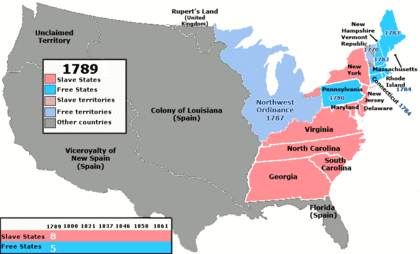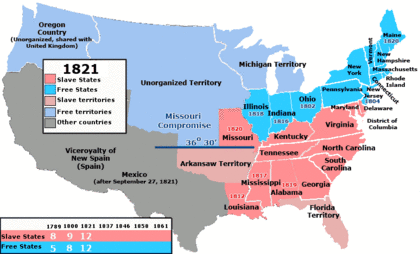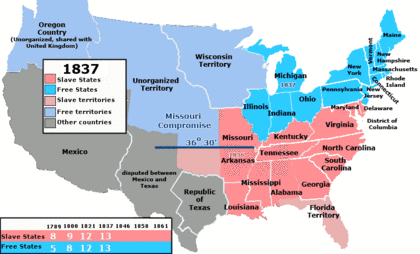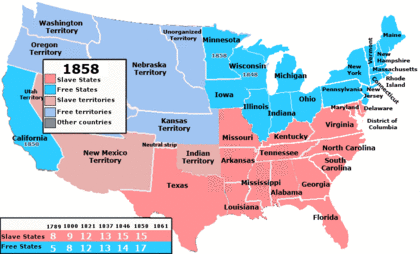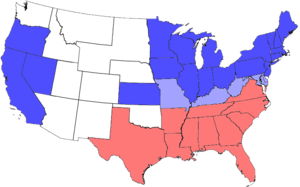Slave and free states facts for kids
In the history of the United States, a slave state was a U.S. state where slavery was allowed by law. A free state was a state where slavery was against the law. Slavery was a big problem that divided the country. It was one of the main reasons for the American Civil War. In 1865, the Thirteenth Amendment to the United States Constitution made slavery illegal everywhere in the United States. After this, the terms "slave state" and "free state" were no longer used because all states became free.
Contents
Early Days of Slavery
Slavery was legal and practiced in all Thirteen Colonies before the United States became a country. People started to form groups to end slavery in the mid-1700s. Many Black Americans joined the American Revolutionary War hoping to gain their freedom. Others joined the British army, who promised them freedom for fighting. However, the British did not keep their promises after losing the war.
In the 1770s, Black people in New England asked their state governments for freedom. During the meeting to create the Constitution of the United States, slavery was a big topic. It almost stopped the new constitution from being approved. As a compromise, slavery was recognized in the Constitution, but it was never directly named. An example is the Fugitive Slave Clause. This clause said that enslaved people who escaped to free states had to be returned to their owners.
By 1789, five northern states began to slowly end slavery. These were Pennsylvania (1780), New Hampshire and Massachusetts (1783), and Connecticut and Rhode Island (1784). Vermont ended slavery in 1777, before it joined the U.S. When Vermont joined in 1791, it was the first state to enter the Union without slavery. By 1804, all northern states had ended slavery or had plans to do so over time.
In the southern United States, Kentucky became a slave state in 1792. It was formed from part of Virginia. Tennessee became a slave state in 1796, from part of North Carolina. By 1803, after Ohio joined the U.S., there were nine free states and eight slave states. The dividing line between the northern free states and southern slave states became known as the Mason–Dixon line. In 1820, the Missouri Compromise extended this line westward. It became the official border between free and slave states east of the Ohio River.
New Lands and New Rules
The Northwest Ordinance of 1787 was passed before the U.S. Constitution was approved. It made slavery illegal in the Northwest Territory. The southern border of this territory was the Ohio River. This was seen as an extension of the Mason–Dixon line to the west. People from New England and soldiers from the Revolutionary War settled this area. The states created from this territory were all free states. These included Ohio (1803), Indiana (1816), Illinois (1818), Michigan (1837), Iowa (1846), Wisconsin (1848), and Minnesota (1858).
The War of 1812 and Its Impact
During the War of 1812, the British offered freedom to all enslaved people who came to them. This was different from the Revolutionary War, where freedom was only offered for military service. By the end of the War of 1812, the movement to end slavery in each state seemed to slow down. Half of the states had already ended slavery or were in the process of doing so. The other half wanted to keep slavery within their borders.
At the national level, politicians worried about the balance of power. Each state had two senators. If there were an equal number of slave and free states, the Senate would be divided. This meant that important issues for the South could not be decided. Both the North and South were concerned about new western territories. They wondered if new states would join as free states or slave states.
The Missouri Compromise
The question of whether Missouri should be a slave state caused a big argument. This led to the Missouri Compromise of 1820. It stated that land from the Louisiana Purchase north of a certain line (36° 30' latitude) would become free states. Land south of that line would become slave states. As part of this deal, Maine (1820) joined as a free state. This balanced Missouri's entry as a slave state (1820).
The North's population grew faster due to industries. This meant the House of Representatives had more votes from free states than from slave states. To deal with this, the House made a "gag rule" in 1836. This rule stopped the House from discussing any anti-slavery requests. It was removed on December 3, 1844.
Texas and New Territories
When Texas joined the U.S. in 1845, and after the U.S. gained new lands from Mexico in 1848, more conflicts arose. Texas had many cotton farms and relied on slavery. But the new western lands did not seem good for cotton or slavery. As part of the Compromise of 1850, California joined as a free state (1850). It did not have a slave state joining at the same time to balance it. To avoid a free state majority in the Senate, California agreed to send one senator who supported slavery and one who opposed it.
Final Conflicts Before the War
It was hard to find new areas that could become slave states. This slowed down the process of opening western lands for settlement. Politicians who supported slavery tried to find solutions. They tried to get Cuba (in 1852) and to take over Nicaragua (in 1856–57). Both were planned to become slave states.
In 1854, the Missouri Compromise of 1820 was replaced by the Kansas–Nebraska Act. This law allowed white male settlers in new territories to decide if they would allow slavery. They would vote on it themselves. This led to people who supported and opposed slavery rushing into Kansas to vote. This conflict was called Bleeding Kansas. There was an attempt to make Kansas a slave state. It was meant to join with Minnesota as a free state. But Kansas's entry as a slave state was blocked because of questions about its slave state constitution. Anti-slavery settlers in Kansas in the 1850s were called Free-Soilers. They fought to make Kansas a free state, and it joined the Union as a free state in 1861. When Minnesota joined without problems in 1858, the balance in the Senate was lost. Oregon joined as a free state in 1859.
Slavery Comes to an End
At the start of the Civil War, the United States had 34 states. Fifteen of these were slave states. Eleven of these slave states left the United States to form the Confederate States of America. The slave states that stayed with the Union were Maryland, Missouri, Delaware, and Kentucky. These were called the border states.
By the time the Emancipation Proclamation was issued in 1863, Tennessee was already under Union control. So, the Proclamation only applied to the 10 remaining Confederate states. Ending slavery also became a condition for these states to rejoin the United States. The Thirteenth Amendment to the United States Constitution officially ended slavery across the entire United States on December 18, 1865. This ended the difference between slave and free states forever.
Images for kids
See also
 In Spanish: Estados libres y estados esclavistas para niños
In Spanish: Estados libres y estados esclavistas para niños


